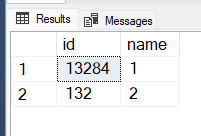I know I've done this before years ago, but I can't remember the syntax, and I can't find it anywhere due to pulling up tons of help docs and articles about "bulk imports".
Here's what I want to do, but the syntax is not exactly right... please, someone who has done this before, help me out :)
INSERT INTO dbo.MyTable (ID, Name)
VALUES (123, 'Timmy'),
(124, 'Jonny'),
(125, 'Sally')
I know that this is close to the right syntax. I might need the word "BULK" in there, or something, I can't remember. Any idea?
I need this for a SQL Server 2005 database. I've tried this code, to no avail:
DECLARE @blah TABLE
(
ID INT NOT NULL PRIMARY KEY,
Name VARCHAR(100) NOT NULL
)
INSERT INTO @blah (ID, Name)
VALUES (123, 'Timmy')
VALUES (124, 'Jonny')
VALUES (125, 'Sally')
SELECT * FROM @blah
I'm getting Incorrect syntax near the keyword 'VALUES'.



INSERT INTO @blah (ID, Name) VALUES (123, 'Timmy'), (124, 'Jonny'), (125, 'Sally')"VALUES" only appears once and you need commas between the sets. – Although